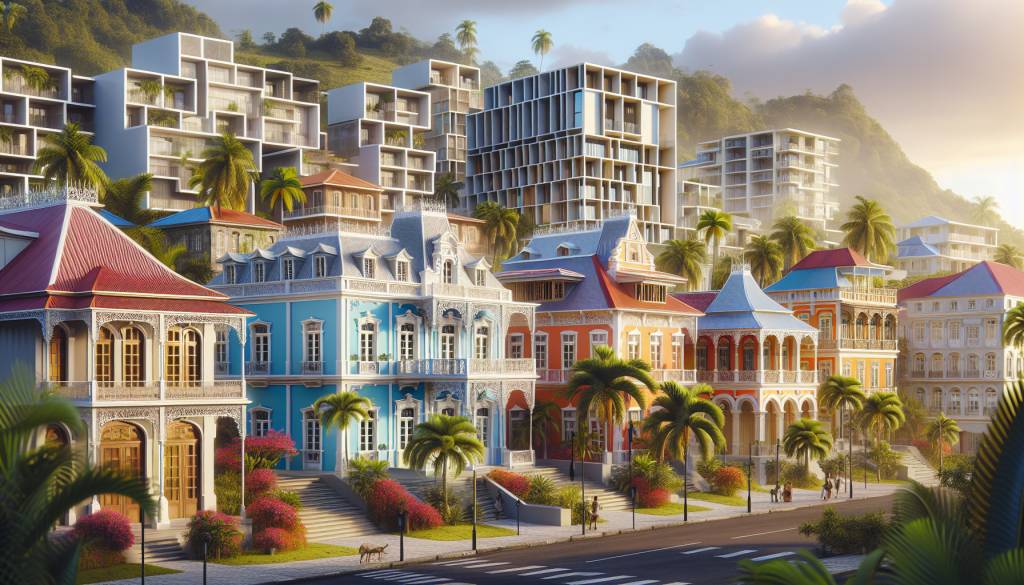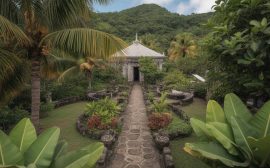Exploring the Rich Architectural Heritage of Martinique
Martinique, a gem of the Caribbean, is not only known for its breathtaking beaches and lush landscapes but also for a rich tapestry of architectural delights. The island’s built environment chronicles a storied past, encapsulating a unique blend of influences from Amerindian, African, and European cultures, in addition to contemporary advancements. This rich mix has fostered an array of structural wonders that beckon travelers who have a keen eye for design and history.
Colonial Elegance: A Glimpse into Martinique’s Past
As you wander through the streets of Martinique, you are taken back in time by the quaint colonial architecture that dots the landscape. The La Pagerie Museum, birthplace of Empress Joséphine, features typical Creole architecture with its wooden fretwork and airy verandas designed to provide respite from the tropical heat. The bustling city of Fort-de-France offers a look into the island’s colonial heritage with landmarks such as Fort Saint-Louis, an active naval base that dates back to the 17th century, and La Savane Park, surrounded by historic statues and old-world charm.
The colonial influence is further exemplified by the Schoelcher Library, named after the abolitionist Victor Schoelcher. This building, originally constructed in Paris for an exposition in 1889, was later shipped and reassembled in Martinique, representing the island’s lasting links with France.
Religious Edifices: Testaments of Time and Faith
The diverse architectural landscape of Martinique is enriched by its religious structures. The iconic Cathedral of Saint-Louis in Fort-de-France, with its Romanesque Revival style and tall, grey spire, stands as a testament to the island’s dedication to preserve its spiritual history amidst natural disasters like hurricanes and volcanic eruptions.
In contrast, the tranquil Balata Church, a smaller replica of Paris’s famed Sacré-Cœur Basilica, offers visitors a serene retreat with panoramic views, providing insights into the amalgamation of religious reverence and architectural inspiration that defines the island’s ecclesiastical structures.
Plantation Houses: Echoes of Agricultural Heritage
The history of Martinique is invariably tied to its agricultural past, particularly the cultivation of sugarcane, banana, and pineapple. Plantation houses, known locally as ‘Habitations’, capture this essence beautifully. One remarkable example is the Habitation Clément, which not only serves as a museum showcasing plantation life but also as a vibrant cultural center, inviting guests to explore its past and present glory through vibrant art installations and rum tastings.
These majestic homes, set amidst sprawling estates, provide a window into the plantation economy and the varied lives of those who managed and toiled within them. The architecture of these houses combines functional features with ornate detail, opening up opportunities to witness the socioeconomic history of Martinique.
Contemporary Creole Fusion: Modernity Meets Tradition
Moving away from the past, Martinique also embraces contemporary architecture, which reflects a seamless fusion between tradition and modernity. Contemporary Creole structures are characterized by bright colors, innovative materials, and sustainable designs that celebrate Martinique’s climatic conditions and cultural roots.
New constructions take environmental factors into account, utilizing natural ventilation and incorporating local materials. A prime example of this modern architectural approach is the AIM Césaire Theater in Fort-de-France. Named after the esteemed poet and politician Aimé Césaire, this modern complex respects the natural environment while providing a state-of-the-art venue for the performing arts.
Fort-de-France: A Hub of Architectural Diversity
The capital city, Fort-de-France, epitomizes Martinique’s architectural journey from its colonial buildings to contemporary structures. Constructed over centuries, each building in the city tells a unique story, reflecting the island’s resilience and capacity for renewal. From historic fortifications to new administrative buildings, the cityscape is a living museum of architectural progress.
Whether you are enjoying the hustle and bustle of the city’s markets or taking a quiet stroll along the seaside promenades, the juxtaposition of old and new creates an ambiance that is distinctly Martinican and provides engaging content for both history buffs and architectural enthusiasts.
Preservation and Innovation: The Future of Martinique’s Architecture
As a forward-thinking island, Martinique not only prides itself on its historical architecture but also its dedication to preserving and innovating these structures for future generations. Initiatives are in place to protect landmarks through restoration projects, while new construction is approached thoughtfully, ensuring that Martinique’s architectural heritage is celebrated and sustained.
The architectural wonders of Martinique traverse the spectrum from time-honored colonial edifices to avant-garde contemporary structures. For travelers seeking to immerse themselves in cultural depth, Martinique presents a spellbinding narrative shaped by its architecture—a mix of resilience, beauty, and the island’s indomitable spirit. Exploring Martinique’s architectural landscape is not merely a journey through its physical structures but a profound encounter with its soul, its history, and its unyielding march towards the future.
Embarking on a tour of Martinique’s architectural wonders offers an enlightening insight into the island’s multifaceted charm. From the echoes of the past to the innovations of the present, the island beckons visitors to delve into its rich heritage and unwrap the stories etched into its skyline.




